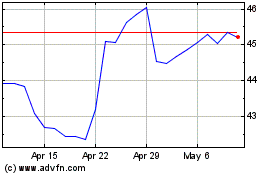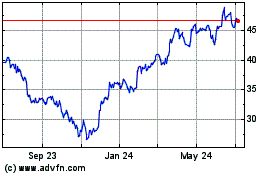GM's Long History of Trying to Turn Around Opel
February 14 2017 - 2:12PM
Dow Jones News
By William Boston
BERLIN -- General Motors Co.'s talks with Peugeot over Opel
aren't GM's first flirtation with unloading its German
subsidiary.
As far back as 1936, just seven years after GM rescued Germany's
top auto maker from the Great Depression and five years after it
took full control, some GM executives proposed selling a stake to
German investors to pre-empt Hitler from taking full control.
Alfred P. Sloan, who created GM from a collection of smaller
U.S. car makers, nixed the idea because he had bigger plans for
Opel.
"When Germany does overcome her difficulties, as she eventually
will, then General Motors will be in a position to take advantage
of the hard work and progress which has been made during the past
seven or eight years in the form of profits which are transferrable
to America," he told fellow executives.
Since then GM has walked a tightrope with Opel, balancing the
hope of churning out big profits in Europe and the headaches of
owning a frequently unprofitable German company that many Germans
consider to be American.
GM came close to selling Opel in 2009, but decided to take one
more shot at success in Europe. Now, it seems GM has run out of
reasons to stay and said Tuesday it was discussing the sale of Opel
to French rival Peugeot in a move to pull back from Europe and
focus on its home U.S. market.
GM Opel, which includes the British auto maker Vauxhall, is
Europe's sixth-largest car maker by sales, with a market share of
nearly 7%. Volkswagen AG, the world's leading car maker by sales,
is the biggest-selling manufacturer in Europe, claiming 24% market
share last year.
Before the rise of Volkswagen's storied Beetle in postwar
Germany, Opel was the closest thing to a "people's car" that German
industry had developed. Opel earned its reputation as the family
ride with its now legendary Kadett, developed by Heinrich Nordhoff,
who after the war would lead Volkswagen and transform the Beetle
into a global icon.
Opel's Kadett continued to roll off the assembly line in
Rüsselsheim, near Frankfurt, until the 1990s, when it was replaced
by Opel's best-selling model, the Astra.
In the wake of the global financial crisis and GM's bankruptcy
in the U.S., Opel again descended into crisis. GM put Opel on the
block. An offer by Italian auto maker Fiat SpA was rejected by the
German government. Then, after months of negotiations and lobbying
to win over Chancellor Angela Merkel's government, GM announced in
September 2009 that it would sell Opel to Magna International Inc.,
an auto assembler owned by Austria's Frank Stronach.
But GM had a change of heart. Two months after announcing the
Magna deal, GM pulled out. The new GM management decided that it
also had long-term strategic ambitions for its German
subsidiary.
GM embarked on a massive restructuring of its European business,
even winning German support to close one of its major factories in
Bochum. New GM Europe CEO Karl-Thomas Neumann, a former CEO of
supplier Continental AG, set out to reach profitability by
2016.
"The turnaround is hard," Mr. Neumann said at the beginning of
last year. "But we still want to reach break-even in 2016."
He almost made it, but then the British voted in a national
referendum to leave the European Union last June, sending the
British currency plummeting and creating losses on foreign exchange
at GM's European business. After struggling for years, GM Europe
again missed its target, reporting a $257 million loss on revenue
of $18.7 billion last year.
Write to William Boston at william.boston@wsj.com
(END) Dow Jones Newswires
February 14, 2017 13:57 ET (18:57 GMT)
Copyright (c) 2017 Dow Jones & Company, Inc.
General Motors (NYSE:GM)
Historical Stock Chart
From Mar 2024 to Apr 2024

General Motors (NYSE:GM)
Historical Stock Chart
From Apr 2023 to Apr 2024
